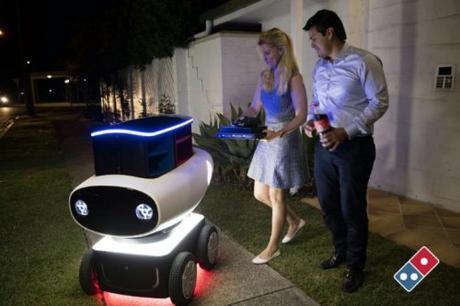Pretty soon the “Fight for $15” crowd will be fighting just to find a job.

Domino’s new trial pizza delivery robot in New Zealand is just under a meter (three foot) high and contains a heated compartment that can hold up to 10 pizzas. (AFP Photo/)
Via SF Gate: Domino’s announced last Friday it’s testing a pizza deliveryman robot in New Zealand with a four-wheeled, short and squat droid who looks like a cross between a Wall-E and an R2D2. At the same time, Carl’s Jr. CEO Andy Pudzer told Business Insider this week he wants to build a fully-automated restaurant.
What’s more, Google is in the news for sending a letter to U.S. transportation officials saying it should be legal to market and sell self-driving cars if they can pass standardized federal safety tests. Once this all gets sorted out, Uber, Lyft and taxi car drivers will be out of jobs.
A robot is any machine capable of carrying out a complex series of actions and typically programmable by a computer—and we’re increasingly seeing these high-tech machines replacing jobs once performed by humans. At the airport ticket counter, at the grocery store checkout line and at the bridge tool booth, we’re less frequently looking a human in the eye when we hand over our money. Instead, we’re dealing with a computer.
At the annual meeting of the American Association for the Advancement of Science in Washington, D.C., in February, Professor Moshe Vardi said robots will take over most jobs in 30 years, the British Telegraph reported. “We are approaching a time when machines will be able to outperform humans at almost any task,” said Vardi, a professor in computational engineering at Rice University.
He added: “Robots are doing more and more jobs that people used to do. Pharmacists, prison guards, boning chicken, bartending, more and more jobs we’re able to mechanize them.”
The high-tech world is even finding ways to use computers to do jobs that seem as if they’d require a human mind. The LA Times uses what’s known as QuakeBot to quickly write and publish news about recent earthquakes.
Businesses are turning to robots because they can save money. Carl’s Jr.’s Pudzer said he’s investing in the automated restaurants because minimum wages continue to go up across the country.
“With government driving up the cost of labor, it’s driving down the number of jobs,” he told Business Insider. “You’re going to see automation not just in airports and grocery stores, but in restaurants.”
But as technology advances and swallows up an increasing number of jobs, some question whether the bottom line should only be about money. What about the loss of jobs? And the overall loss of human connection? Research shows that people benefit from social interactions and can happen at the grocery store, at the bank, at the library when there’s an actual person behind the counter or at the cash register.
At the Advancement of Science conference Professor Vardi posted a profound question: “Does the technology we are developing ultimately benefit mankind?”
See the gallery of some super-high-tech robots replacing jobs at the SF Gate web site here.
DCG

